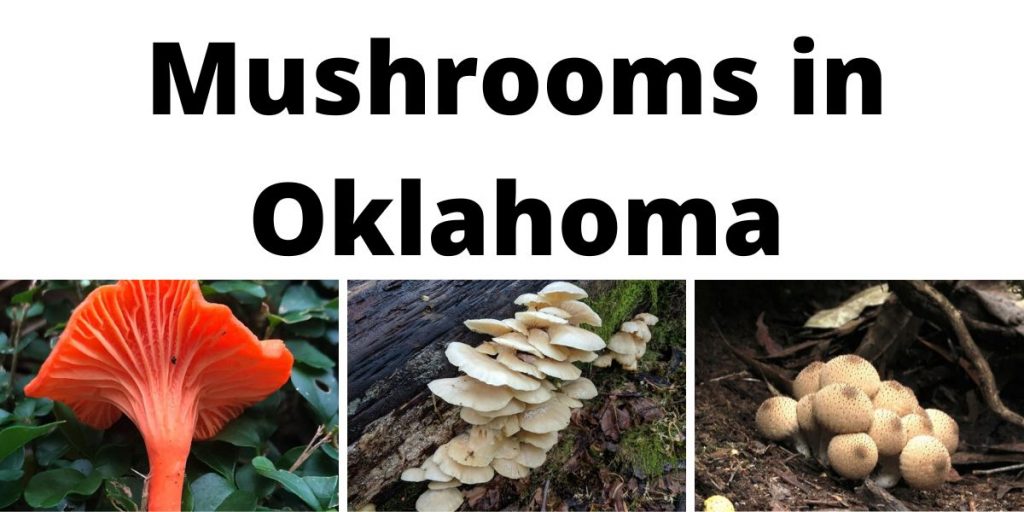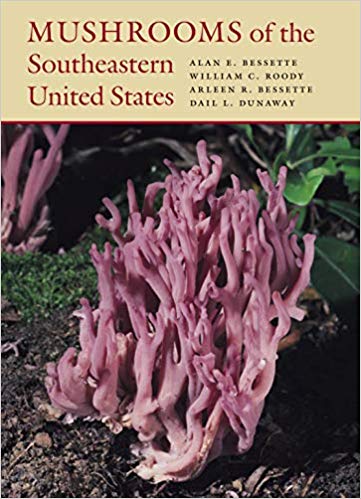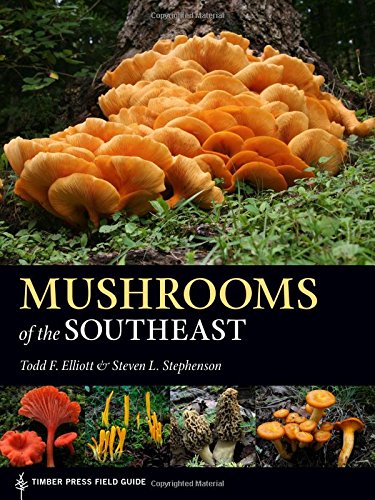Oklahoma[i] is an incredibly diverse state, geographically, encompassing forests, prairies, and mountains, so it’s not surprising that the state has a lot of mushrooms[ii]. We can’t describe all of them, but we can explore some of the more interesting groups.
It’s important not to use articles like this one as instruction manuals to begin foraging with. Although identifying mushrooms is not inherently difficult (at least not usually), it’s unfamiliar territory for most people, and noticing differences between equally unfamiliar things is hard. Foraging for the table is an activity best reserved for experts, people who are experienced at identifying mushrooms and really know what they’re seeing and how to look. Identifying mushrooms can be a rewarding activity all by itself, without associated differ plans, just as birding is.
So this article isn’t abut getting beginners to go foraging—it’s about giving beginners a reason to learn enough that they can go foraging.
If you do indeed go Mushroom Hunting make sure you have the proper tools, take a quality knife with you and a basket/bag for your haul!
This list is not meant to be used as a replacement for a field guide, spore prints, an identification app or an in person guide.
Our Recommended Field Guides for Oklahoma
COVER | TITLE | Header | ||
|---|---|---|---|---|
OUR #1 RATED | ||||
Edible Mushrooms in Oklahoma
Edible LBMs
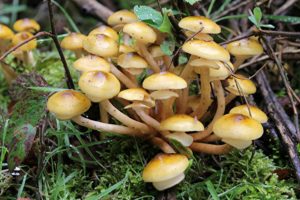

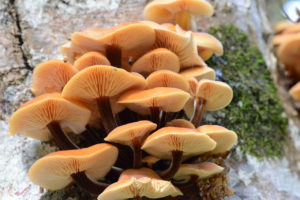

LBM stands for “little brown mushroom,” a large group of mostly-unrelated, nondescript mushrooms that all look very much alike. They range from brown or red-brown to brownish or brownish-gray in color. Some are culinary, some are “magic,” and some are dangerously poisonous. It is therefore wise to either not use any LBMs at all, or to get very good at mushroom identification. Oklahoma has at least three edible species.
Honey mushrooms (Armillaria sp.), named for their color, not their taste, are good table fare for most people but have poisoned a few—no one knows yet what determines who can eat honeys safely and who can’t[iii]. Honey taxonomy is a bit of a mess[iv], but Oklahoma appears to have at least two species, one with a ring on the stem and one without. Velvet foot (Flammulina velutipes)[v] has a secret identity, for when cultivated in the dark with restricted oxygen, this normally broad-capped brown mushroom grows white with a tiny cap, rather like a bean sprout. Both versions are good to eat, but the latter is more often sold, usually under its Japanese name, enoki.
Oyster Mushrooms (Pleurotus sp.)
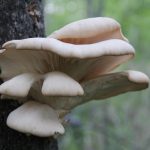

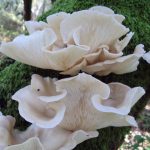

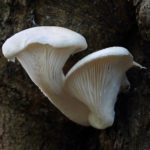

Oyster mushrooms are also named for their appearance—they don’t taste like oysters. Instead, most species have a delicate, sometimes perfumed flavor. Oklahoma has at least four species. Pleurotus ostreatus is the one most people mean if they say “oyster mushroom” without specifying. Aspen Oyster (P. populinus) and Summer Oyster (Pleurotus pulmonarius) look almost identical to it but are paler and have slightly different substrate preferences and fruiting times[vi]. Veiled oyster (P. dryinus)[vii], as the name implies, is distinctive in having a partial veil when immature, but the veil remnants are not always visible on mature mushrooms.
Inky Caps
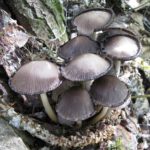

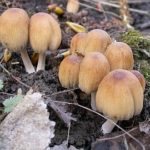

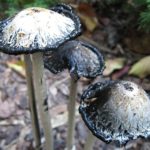

The inky caps were once classified in a single genus but have since been split up into multiple genera across two families. Their claim to fame is that at maturity they turn to black goo—but before they do so, most (not all!) are good to eat. Some, but not all, cause temporary alcohol intolerance in eaters. Just don’t drink alcohol for a few days. Oklahoma has at least three edible species.
The Common Inky Cap (Coprinopsis atramentaria)[viii] and the Mica Cap (Coprinellus micaceus)[ix] both cause alcohol intolerance. Shaggy Mane (Coprinus comatus)[x] does not.
Puffballs
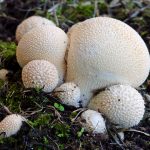

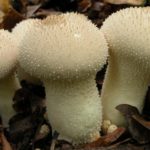

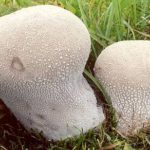



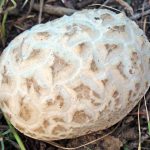

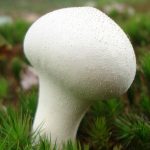





Puffballs[xi] are notable for being ball-shaped (with or without a stalk) with the spores enclosed within the ball. At maturity, either the ball develops a single pore, or the ball ruptures, releasing the spores. There are many species, but most are not closely related to each other. Most (not all) are edible when young, while the interior is still white. Some dangerously toxic species look like puffballs when young, so proper identification is critical. Oklahoma has a large number of edible species.
Many are small to medium-sized and belong to the genus, Lycoperdon. Pear-Shaped Puffballs (L. pyriforme)[xii] are shaped like upside-down pears and grow on wood. Common Puffball (L. perlatum)[xiii] looks gem-studded, thanks to small, wart-like structures. When these fall off, the surface looks lacy. The Mosaic Puffball (L. utriforme orHandkea utriformis)[xiv] is notable for the mosaic of flakes that cover the surface in young specimens. There are also at least three spiny species in the group that are either not edible or not known to be edible.
Other puffs are large to very large in the genus, Calvatia. The Giant Puffball (C. gigantea)[xv] and the Western Giant Puffball (C. booniana)[xvi] are both huge, basketball-size or sometimes bigger. Calvatia bovista[xvii], which appears not to have a common name, is up to about soccer-ball sized with a large, thick stem. The Purple-Spored Puffball (Calvatia cyathiformis)[xviii] is about the same size. Before the spores turn purple, it is considered very good to eat[xix]. The Brain Puffball (Calvatia craniiformis)[xx] is smaller, only about softball size, and often wrinkled. 11
Chanterelles (Cantharellus) and Trumpets (Craterellus)
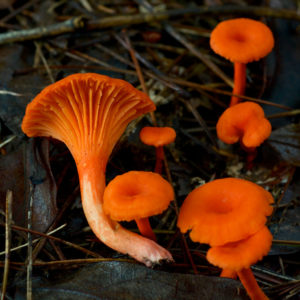

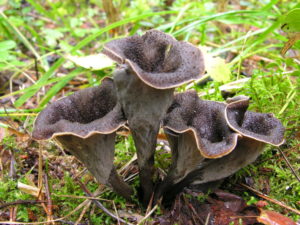

These two genera are closely related and look very similar. In fact, some species have been moved from one to the other, and there are trumpets with “chanterelle” in their common name. Both are notable for not having a distinct cap or gills—instead, the top of the stem flares out very wide, like the bell of a trumpet. The spores are born on ridges or veins on the outside of the bell. They range from good to excellent as table fare, but do have poisonous look-alikes. Oklahoma has at least five species.
Red Chanterelle (Cantharellus cinnabarinus)[xxi] is a pretty little thing. A yellow chant could be any one of a confusing complex of Cantharellus species[xxii]. There are also two species of Black Trumpet (Craterellus cornucopioides and C. fallax) that are very difficult to tell apart[xxiii] but reportedly both are lovely in cream sauce.
And Now for Something Completely Different
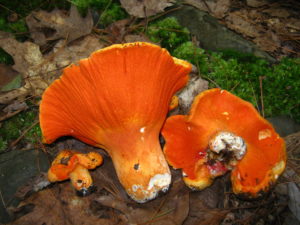

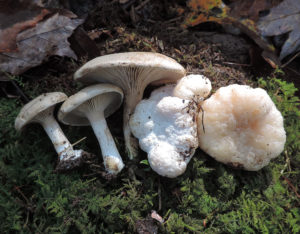

Sometimes what appears to be a single kind of mushroom is a bit more complicated. Oklahoma has at least two edible examples. Lobster Mushroom[xxiv] is the result of an orange mold (Hypomyces lactifluorum) attacking and deforming the mushrooms of any of several species in the Russula or Lactarius genera. It’s almost impossible to identify the host species. Now, some members of each of those genera are poisonous, but for some reason the conversion to lobsterhood makes the mushroom, regardless of host species, safe to eat (at least when young and fresh) and mildly fish-like in flavor[xxv].
Aborted (or “aborting”) Enteloma[xxvi] is another case of parasitism. Entoloma abortivum does make its own fruiting bodies, but also attacks and deforms the fruiting bodies of nearby honey mushrooms. For years, people thought the strange, contorted mushrooms were Entolomas deformed by attack from honey mushroom fungus. Nope, it’s the other way around. In any case, both E. abortivum and its deformed victims are edible, bu some Entoloma species are poisonous and similar-looking. The presence of both the Entoloma mushrooms and the deformed honeys in close proximity is an important field mark.
Poisonous Mushrooms in Oklahoma
There is no way to tell whether a mushroom is poisonous without identifying it to species-level and looking it up. All short-cut rules of thumb have exceptions and thus can lead to potentially deadly mistakes. Just learn to identify mushrooms. Also, please be aware that this list is not exhaustive; don’t assume that an Oklahoma mushroom is edible just because it’s not on here!
Poisonous Amanitas


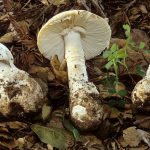

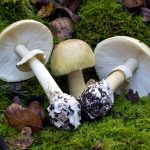

Not all Amanitas are poisonous. In fact, some of Oklahoma’s Amanitas are edible. But among the poisonous species are some of the most dangerous mushrooms on Earth. People who eat these mushrooms can sometimes be saved if they receive proper medical attention, but survival is by no means a sure thing—and the long delay before onset of symptoms, sometimes over a day, makes the problem difficult to diagnose. Although these are large, handsome, distinctive-looking mushrooms, they can be mistaken for many edible species through inexperience or a moment’s inattention.
The destroying angels are a group of large, handsome, white or whitish species that are often mistaken for virtually any other white mushroom of similar size, including some agarics, parasols, inky caps, and puffballs (young Amanitas have an “egg” stage that looks very puffball-like). Oklahoma has two species, A. bisporigera and A. ocreata. The Death Cap (A. phalloides) is white with a green-brown cap. It’s not native to North America but was brought here accidentally on nursery stock. In addition to accidental poisonings, it is thought to have been used for murder in Europe.
Deadly Galerina (Galerina marginata)


The Deadly Galerina contains the same toxin as the most dangerous Amanitas, plus it’s an LBM with a habit of popping up inside clusters of edible (or “magic”) look-alikes. This species is the most obvious reason why every single mushroom headed for a human mouth must first be properly and carefully identified—every single one.
Flowerpot Dapperling (Leucocoprinus birnbaumii)
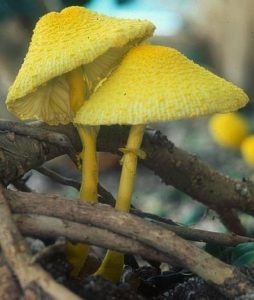

What a lovely name for a lovely little mushroom! The Flowerpot Dapperling[xxvii] is, indeed, a dapper little lemon-yellow mushroom often found growing in flowerpots. It’s a tropical and subtropical fungus, but is often found well north of its native range in the pots of tropical houseplants. It’s harmless to living plants. The main thing is not to eat it—accounts differ as to how poisonous it is, from slightly toxic all the way to potentially deadly. Perhaps it’s better not to find out. Other dapperlings are native to Oklahoma, too, mostly small, pretty, umbrella-shaped mushrooms, many of them likewise poisonous—some seriously so.
Jack O’Lantern (Omphalotus illudens)
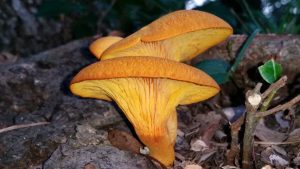

This is one of several species known as jack o’lanterns, all of which are known for two things; glowing in the dark and being a poisonous look-alike of chanterelle mushrooms. Actually, the glow is too faint for most people to see, and the resemblance is slight, but not so slight that nobody makes the mistake. Jack o’lanterns have true gills and chanterelles don’t, but inexperienced foragers especially may overlook the difference. Eating a jack (probably) won’t kill you, but will make you extremely ill.
Earthballs (Scleroderma sp.)
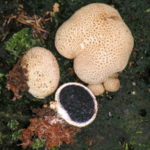

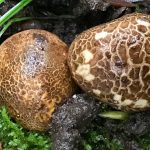

The earthballs are toxic puffballs. They are distinct from other puffballs in several respects—most notably, they are much more firm to the touch and their interiors darken much earlier. They are not lethal, but the effects of eating one are extremely unpleasant. Not that earthballs are not the only poisonous puffballs, but most other puffballs are safe to eat, so the earthballs are unusual. Oklahoma has at least two species, S. citrinum and S. cepa.
Poison Pie (Hebeloma sp.)


Yes, poison pie[xxviii] is poisonous—and not especially pie-like. The toxin is not generally deadly, but still worth avoiding. There are several closely-related poison-pie species in North America, and it’s not entirely clear which one(s) live in Oklahoma.
Magic Mushrooms in Oklahoma
No, magic mushrooms have not, as of this writing, been legalized in Oklahoma[xxix]. Possession and use have been decriminalized, which means that users can still be charged with a misdemeanor, just not a felony. And these still are crimes at the Federal level, too. Please take these laws seriously and do not get arrested.
Various psychoactive mushroom species do grow wild in Oklahoma[xxx]. Do not harvest any of these if you are not already an experienced forager, even if you are familiar with these mushrooms from other contexts. Oklahoma’s psychoactive mushrooms are all LBMs—there are documented human fatalities from people picking and eating what they thought was a magic mushroom and turned out to be a deadly galerina.
The psychoactive mushrooms themselves, those that contain psilocybin as their active ingredient, are relatively safe to use—but they are not absolutely safe. There are risks involved with psilocybin use, and though the risks can be minimized, they can’t be made to entirely go away. Please keep these facts in mind.
Gymnopilus sp.
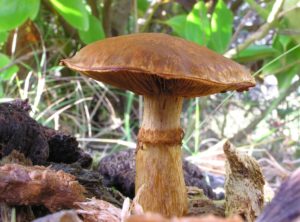

The gymns are not a well-known group. Not a lot of people use them, though those who do tend to enjoy the experience. Taxonomy in the group is still a little muddled, so it’s hard to say which species Oklahoma has.
Panaeolus cinctulus
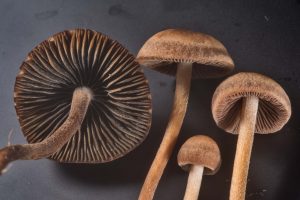

The pans—or mottlegills—are not all psychoactive, but some in the group are very potent. This species, the banded mottlegill, is about medium potency and very widespread.
Psilocybe cubensis
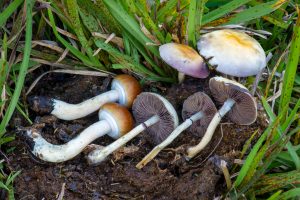

Here we have one of the most well-known psychoactive mushrooms in the world, in part because it’s so widely cultivated. When somebody refers to shrooms or magic mushrooms and doesn’t otherwise specify, this is usually the one they mean. The fact that it is available in many different strains each with their own name can cause confusion, especially since many people don’t know the difference between strains and species. In any case, P. cubensis does grow wild in the southern, warmer, part of the state.
Our Recommended Field Guides for Oklahoma
COVER | TITLE | Header | ||
|---|---|---|---|---|
OUR #1 RATED | ||||
References:
[i] (n.d.). Oklahoma. Wikipedia
[ii] (n.d.). Observations. iNaturalist
[iii] (n.d.). Armillaria mellea (Vahl) P. Kumm.—Honey Fungus. First Nature
[iv] Kuo, M. (2017). Armillaria mellea. MushroomExpert
[v] Volk, T. (1997). This Month’s Fungus Is Flammulina velutipes, also Known as the Winter Mushroom, Velvet Stem, Velvet Foot, Enoki, Enokitake. Tom’s Fungi
[vi] Kuo, M. (2017). Pleurotus pilmonarius. MushroomExpert
[vii] Kuo, M. (2018). Pleurotus dryinus. MushroomExpert
[viii] (n.d.). Coprinopsis atramentaria (Bull,) Redhead, Vilgalys & Moncalvo—Common Inkcap. First Nature
[ix] (n.d.). Coprinellus micaceus (Bull.) Vilgalys, Hopple & Jacq. Johnson—Glistening Inkcap. First Nature
[x] (n.d.). Coprinus comatus (O.F. Müll.) Pers.—Shaggy Inkcap. First Nature
[xi] Kuo, M. (2008). Puffballs. The MushroomExpert
[xii] (n.d.). Lycoperdon pyriforme Schaeff.–Stump Puffball. First Nature
[xiii] (n.d.). Lycoperdon utriforme Bull.–Mosaic Puffball. First Nature
[xiv] (n.d.). Lycoperdon perlatum Pers.–Common Puffball. First Nature
[xv] (n.d.). Clacatia gigantea (Batsch) Lloyd—Giant Puffball. First Nature
[xvi] Wood, M., Stevens, F. (n.d.). California Fungi—Calvatia booniana. California Fungi
[xvii] (n.d.). Calvatia bovista. Wikipedia
[xviii] Kuo, M. (2016). Calvatia cyathifornis. The MushroomExpert
[xix] Bergo, A. (n.d.). Puffball Mushrooms. Forager Chef
[xx] (n.d.). Calvatia craniiformis. Wikipedia
[xxi] Kuo, M. (2015). Cantharellus cinnabarinus. The MushroomExpert
[xxii] Kuo, M. (2015). Cantharellus lateritius. The MushroomExpert
[xxiii] Kuo, M. (2015). Craterellus fallax. The MushroomExpert
[xxiv] Kuo, M. (2003). Hypomyces lactifluorum. The MushroomExpert
[xxv] Bergo, A. (n.d.). Lobster Mushrooms. Forager/Chef
[xxvi] Emberger, G. (2008). Entoloma abortivum. Messiah College
[xxvii] (n.d.). Leucocoprinus birnbaumii. North Carolina Extension Gardener
[xxviii] Wood, M., Stevens, F. (n.d.). California Fungi—Hebeloma crustuliniforme.
[xxix] Tropsitter (2022). Are Psychedelics Legal in Oklahoma Yet? Tripsitter
[xxx] (n.d.). Which Psilocybin Mushroom Grow Wild in My Area? Shroomery

